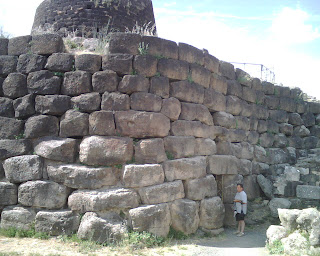Click on the video if you want to add a soundtrack to this post. American-Italian Jazz guitarist Al Di Meola partners with late Sardinian singer Andrea Parodi in a song that talks about ancestral memories. Dedicated to my ancestors and my fellow Sardinians.

Cannonau or Garnacha?

The old conundrum of “The chicken and the egg”
Which one came first? This question is lately stirring-up some controversy. Most Sommeliers and wine writers are of the opinion that Cannonau (Sardinian’s most important red varietal) is the result of the Spanish influence to the western Mediterranean Island Spain
Garnacha, (aka Grenache, Tocai Rosso, Alicante France ’s Cotes du Rhône, Languedoc-Roussillion, Côte-Rôtie and Provence , Spain ’s Priorato, Montsant and Rioja , Australia , California and Sardinia all embraced this grape varietal that thrives in both relatively high elevation and arid climatic conditions. It can reach high alcohol contents and in the French AOC Banyuls, Australia , and Sardinia it can often be vinified as a port-like wine.
When I studied to become a Sommelier with the Association of Italian Sommeliers (AIS) we were taught (but stubborn as the true Sardinian that I am I was never convinced) that Cannonau owes its origins to the Spanish colonization of Sardinia . Some internationally acclaimed wine publications, such as the overall well-documented book “Wine” by André Dominé” states that Cannonau is a grape of Spanish origins because in Tuscany it is called Alicante (Alicante is a wine region of Spain, not the name of a varietal, that focuses on Monastrell, not Garnacha). He also makes the mistake of saying that the best Cannonau comes from the D.O.C. Carignano del Sulcis, which is a Carignan-based wine; it is like saying that the best “Nebbiolo” of Piemonte comes from Dolcetto d’ Alba. The Hugh Johnson and Jansin Robinson’s “The World Atlas of Wine” merely classifies Cannonau as the Spanish Garnacha and does not elaborate on any specific area of production. This is just to mention a few publications of relevance available to the public, and shows how poor the research is on the topic. On the other hand, when I studied for the C.S.W. certification, I was pleased that the American-based Society of Wine Educators’ study program puts emphasis on questioning the Spanish or French origins of Grenache and embraces the possibility it originated in Sardinia .
Until recent times it was commonly agreed that Garnacha originated in Spain and from there it was brought to the Mediterranean Islands (Baleares, Corsica and Sardinia) and as well as to southern of France
However, Giovanni Lovicu -- an eminent authority in agronomy and viticulture of the University of Sassari (Sardinia ) -- casted some serious doubts on this globally accepted theory. His research is based on ancient traces of commerce from Sardinia to the rest of the Mediterranean , as well as the lack of documentation that would show the contrary.
Recorded history gives us proof that ancient Romans were instrumental in spreading vine-growing throughout the western part of the Mediterranean regions. However, Roman expansion to the west started “barely” 2300 years ago. When the Romans won the second Punic war against Carthage in the mid 3rd century B.C. they conquered Sardinia and named it “Insula Vini” (Island of wines) because of the amount of vines planted on the island.
So, how ancient really is winemaking in Sardinia ? Science and archeology are leading us to new discoveries that are in conflict with the old paradigm that sees Sardinia succumbed to its colonizers’ influence. Recent discoveries thorough archaeological finds in the ruins of several Sardinian Nuraghes -- megalithic fortresses that pre-date medieval castles by at least 4 millennia -- show that its prehistoric inhabitants of the 2nd millennium B.C. were busy making wine.
And now science gives its support with the use of modern technology. Not too long ago, research in viticulture started to use DNA to identify and select clones that would be more suitable to specific soils and climates. This, in turn, helped making new progress on classifying varietals stemming from the same family, although up until then they were apparently unrelated (like in the case of Primitivo and Zinfandel). The DNA research helped develop a method to trace grape varietals’ origins, and since then, some truths have come out, as well as some doubts.
Grenache is a grape varietal that -- maybe more than any other -- is enshrouded in the mystery and controversy of its own origins, but it is not the only case of controversy in the Sardinian spectrum of native varietals. A parallel issue can be found in the recent archeological findings of intact grape seeds that date back to 1300 B.C. on which the DNA analysis confirmed they were seeds of Muristellu, a Sardinian autochthonous varietal that is also known as Monastrell in Spain, Mataró in Portugal and Mourvèdre in the south of France. How did this varietal get to the rest of Europe ? Or how did it get to Sardinia for that matter? This find puts some serious doubts on Spain Europe ?
Back in the height of the Bronze Age, Sardinia was the most powerful civilization of the Western Mediterranean . Its inhabitants were called the “Shardana” and for over a thousand years they held the monopoly of the bronze trade from the eastern part of the Mediterranean to the far west. Nuragic bronze ingots and artifacts along with pottery, specifically the type called Askos (the purpose of which was the storage and serving of wine) were found throughout the Mediterranean in places such Crete, Tunisia (Carthage), Sicily, Tuscany and as far as Tartessos on the Atlantic coast of Spain. All this information however, steers us towards a direction that makes no sense from an historical point of view when pondering on the following facts:
1) Sardinia is an island, so at a certain point people must have migrated there from mainland. Roughly 1,700,000 souls inhabit it and it’s the second largest island of the Mediterranean . (The first being Sicily
2) Through the ages Sardinia felt pray to several colonizing powers starting with the Phoenicians in 900 B.C., then Carthage
3) In more recent history Sardinia was colonized by the Spanish Crown for approximately three centuries, from 1406 – 1708, and lastly became integral part of the Kingdom of Italy
One of the advantages of conquering another nation is that the winner writes the history. Keeping that in mind, three centuries of Spanish occupation in Sardinia would justify the presence of Spanish varietals on the island as common sense would dictate. However, if that were true, it would have also made sense that Spaniards would have exported Garnacha (let alone Tempranillo and all other major Spanish grapes) to all Spain South America ? Garnacha did not make it to California until European settlers started planting grapes in the late 1800’s, just like in Australia Sardinia has been making wine since ancient times, so why would the Spanish Crown impose the planting of a non-indigenous varietal in a place that had so many to offer?
In order to better understand the origins of the varietal, one has to understand the origins of its name. Lovicu states that the etymology “Garnacha” stems from “Vernaccia”, which stems from the Latin word “Vernaculus”, which literally means “of that place”. This alone proves that it’s a derivation of something more ancient, from which we can deduce it’s not a Spanish etymology in first place. Or better yet: this does not prove Garnacha is not from Spain but rather it would seem more like the Romans found it there and named it “Vernaculus”. After all, we have more examples of varietals names that stem from this etymology: the Tuscan Vernaccia di S. Giminiano, the South Tyrol Vernatsch (Schiava), Marche ’s Vernaccia di Serrapetrona and Sardinia ’s Vernaccia di Oristano. All these varietals have nothing else in common besides the root of their name.
However, Lovicu’s historical research of the etymology leads us to a document he obtained from the Spanish archives, the first ever to show proof of the word Garnacha. It is a Spanish document that dates back to the middle 18th century and attests the purchase of a specific amount of barrels of “Guarnaccia” (misspelling of Vernaccia, a Sherry-like white wine vinified and oxidized with the “Flor” type of yeast, still produced in the town of Oristano on the western part of the Island ). These barrels of “Guarnaccia” were shipped from Sardinia to Spain
As far as my father could remember, and still when I was a child in the 70s back in Sardinia , my grandfather owned a vineyard of Vernaccia in the village I was born. He made wine for his family’s consumption. My grandfather, my father, my uncles and all the elders I knew, always called Vernaccia with the Sardinian name of “Crannaccia”. Is it just a coincidence? Is “Garnacha” the egg, or is it the chicken?



